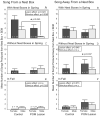Lesions to the medial preoptic nucleus differentially affect singing and nest box-directed behaviors within and outside of the breeding season in European starlings (Sturnus vulgaris)
- PMID: 17201478
- PMCID: PMC2567826
- DOI: 10.1037/0735-7044.120.6.1326
Lesions to the medial preoptic nucleus differentially affect singing and nest box-directed behaviors within and outside of the breeding season in European starlings (Sturnus vulgaris)
Abstract
Little is known about how the brain regulates context-appropriate communication. European starlings produce song in various social contexts. During the breeding season, males with nest sites sing high levels of sexually motivated song in response to a female. Outside of this context, song rates are not affected by female presence. The medial preoptic nucleus (POM) regulates male sexual behavior, and studies in songbirds implicate the POM in sexually motivated song. Recent data suggest that the role of the POM might extend to song produced in other contexts as well. To examine this possibility, effects of bilateral electrolytic lesions of the POM on singing and other behaviors in adult male starlings within sexually relevant and nonsexual contexts were studied. Lesions to the POM exclusively reduced song and nest box-directed behaviors within highly sexually relevant contexts. Unexpectedly, POM lesions increased song in a nonsexual context, suggesting an inhibitory role for the POM in this context. These data suggest that the POM interacts with the song control system so that song occurs in an appropriate social context in response to appropriate stimuli.
2006 APA, all rights reserved
Figures



Similar articles
-
Evidence for opioid involvement in the motivation to sing.J Chem Neuroanat. 2010 Mar;39(2):141-50. doi: 10.1016/j.jchemneu.2009.03.008. Epub 2009 Apr 5. J Chem Neuroanat. 2010. PMID: 19995531 Free PMC article. Review.
-
Seasonal changes in courtship song and the medial preoptic area in male European starlings (Sturnus vulgaris).Horm Behav. 2000 Dec;38(4):250-61. doi: 10.1006/hbeh.2000.1623. Horm Behav. 2000. PMID: 11104643
-
Lesions to the medial preoptic nucleus affect immediate early gene immunolabeling in brain regions involved in song control and social behavior in male European starlings.Eur J Neurosci. 2009 Mar;29(5):970-82. doi: 10.1111/j.1460-9568.2009.06637.x. Epub 2009 Feb 24. Eur J Neurosci. 2009. PMID: 19245371 Free PMC article.
-
D1-like dopamine receptor density in nuclei involved in social behavior correlates with song in a context-dependent fashion in male European starlings.Neuroscience. 2009 Mar 31;159(3):962-73. doi: 10.1016/j.neuroscience.2009.01.042. Epub 2009 Jan 27. Neuroscience. 2009. PMID: 19356680 Free PMC article.
-
Pleasure seeking and birdsong.Neurosci Biobehav Rev. 2011 Oct;35(9):1837-45. doi: 10.1016/j.neubiorev.2010.12.017. Epub 2011 Jan 18. Neurosci Biobehav Rev. 2011. PMID: 21251924 Free PMC article. Review.
Cited by
-
Evidence for opioid involvement in the motivation to sing.J Chem Neuroanat. 2010 Mar;39(2):141-50. doi: 10.1016/j.jchemneu.2009.03.008. Epub 2009 Apr 5. J Chem Neuroanat. 2010. PMID: 19995531 Free PMC article. Review.
-
Modulation of male song by naloxone in the medial preoptic nucleus.Behav Neurosci. 2013 Jun;127(3):451-7. doi: 10.1037/a0032329. Epub 2013 Apr 1. Behav Neurosci. 2013. PMID: 23544595 Free PMC article.
-
A novel statistical method for behaviour sequence analysis and its application to birdsong.Anim Behav. 2016 Jun;116:181-193. doi: 10.1016/j.anbehav.2016.04.001. Epub 2016 May 13. Anim Behav. 2016. PMID: 27667850 Free PMC article.
-
Vocal parameters that indicate threat level correlate with FOS immunolabeling in social and vocal control brain regions.Brain Behav Evol. 2012;79(2):128-40. doi: 10.1159/000334078. Epub 2011 Dec 17. Brain Behav Evol. 2012. PMID: 22179056 Free PMC article.
-
Mu opioid receptors in the medial preoptic area govern social play behavior in adolescent male rats.Genes Brain Behav. 2020 Sep;19(7):e12662. doi: 10.1111/gbb.12662. Epub 2020 May 18. Genes Brain Behav. 2020. PMID: 32388931 Free PMC article.
References
-
- Ball GF, Balthazart J. Hormonal regulation of brain circuits mediating male sexual behavior in birds. Physiology & Behavior. 2004;83(2):329–46. - PubMed
-
- Ball GF, Riters LV, Balthazart J. Neuroendocrinology of song behavior and avian brain plasticity: multiple sites of action of sex steroid hormones. Front Neuroendocrinol. 2002;23(2):137–78. - PubMed
-
- Bottjer SW, Johnson F. Circuits, hormones, and learning: vocal behavior in songbirds. Journal of Neurobiology. 1997;33(5):602–18. - PubMed
-
- Brenowitz EA, Margoliash D, Nordeen KW. An introduction to birdsong and the avian song system. Journal of Neurobiology. 1997;33(5):495–500. - PubMed

